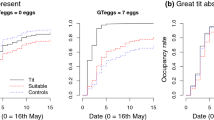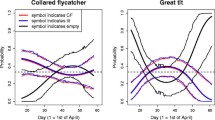Abstract
Dispersers are expected to assess breeding habitat quality before settlement. Although cues reflecting habitat quality are well studied, social cues have not been as well evaluated. In this paper, we studied breeding habitat selection during 3 years in a natural population of blue tits, Cyanistes caeruleus, breeding in nest-boxes. Our aim was to investigate if this species used conspecific density and/or reproductive success of con- and heterospecifics (i.e., social cues) in settlement decisions. The patterns observed were consistent with the idea that juveniles, when dispersing from their natal patches, did not react to any of the cues that we tested. In contrast, breeders that dispersed seemed to respond to both conspecific mean patch reproductive success (PRS) and breeding density of the settlement patch in the year of dispersal, their response differing according to their own reproductive success. Indeed, failed breeders moved to areas with high PRS and low density relative to source patches, while successful breeders behaved the opposite. The comparison between juveniles and adults might be modulated by the limited time available to juveniles to gather information on PRS and density at the end of the dispersing year. Adults lacking these time constraints, however, seemed to rely on these conspecific cues although limited by their own quality. Additionally, breeders were more likely to be immigrants in patches with relatively low breeding success and density the previous year, suggesting that settlement is influenced by multiple cues, which may reveal information on different aspects of habitat and be available at different moments. Collectively, our results support the importance of social cues for blue tits’ settlement.


Similar content being viewed by others
References
Andreu J, Barba E (2006) Breeding dispersal of great tits Parus major in a homogeneous habitat: effects of sex, age and mating status. Ardea 94:45–58
Boulinier T, Danchin E (1997) The use of conspecific reproductive success for breeding patch selection in territorial migratory species. Evol Ecol 11:505–517
Boulinier T, McCoy K, Sorci G (2001) Dispersal and parasitism. In: Clobert J, Danchin E, Dhondt AA, Nichols JD (eds) Dispersal. Oxford University Press, Oxford, pp 169–179
Brown CR, Brown MB (1996) Coloniality in the cliff swallow. The effect of group size on social behaviour. University of Chicago Press, Chicago
Clark RG, Shutler D (1999) Avian habitat selection: pattern from process in nest-site use by ducks? Ecology 80:272–287
Clobert J, Danchin E, Dhondt AA, Nichols JD (eds) (2001) Dispersal. Oxford University Press
Coolen I, Ward AJW, Hart PJB, Laland KN (2005) Foraging nine-spined sticklebacks prefer to rely on public information over simpler social cues. Behav Ecol 16:865–870
Cramp S, Perrins D (eds) (1993) Handbook of the birds of Europe, the Middle East and North Africa: the birds of the western Palaearctic. Oxford University Press
Danchin E, Boulinier T, Massot M (1998) Conspecific reproductive success and breeding habitat selection: implications for the study of coloniality. Ecology 79:2415–2428
Danchin E, Giraldeau LA, Valone TJ, Wagner RH (2004) Public information: from nosy neighbours to cultural evolution. Science 305:487–491
Davis JM, Stamps JA (2004) The effect of natal experience on habitat preferences. Trends Ecol Evol 19:411–416
Delestrade A, Mcleery RH, Perrins CM (1996) Natal dispersal in a heterogeneous environment: the case of the great tit in Wytham. Acta Oecol 17:519–529
Dhondt AA, Adriaensen F (1994) Causes and effects of divorce in the blue tit Parus caeruleus. J Anim Ecol 63:979–987
Dhondt AA, Schillemans J, Delaet J (1982) Blue tit territories in populations at different density levels. Ardea 70:185–188
Dingemanse NJ, Both C, Noordwijk AJv, Rutten AL, Drent PJ (2003) Natal dispersal and personalities in great tits (Parus major). Proc R Soc Lond B 270:741–747
Doligez B, Danchin E, Clobert J, Gustafsson L (1999) The use of conspecific reproductive success for breeding habitat selection in a non-colonial, hole-nesting species, the collared flycatcher. J Anim Ecol 68:1193–1206
Doligez B, Danchin E, Clobert J (2002) Public information and breeding habitat selection in a wild bird population. Science 297:1168–1170
Doligez B, Cadet C, Danchin E, Boulinier T (2003) When to use public information for breeding habitat selection? The role of environmental predictability and density dependence. Anim Behav 66:973–988
Doligez B, Part T, Danchin E, Clobert E, Gustafsson L (2004) Availability and use of public information and conspecific density for settlement decisions in the collared flycatcher. J Anim Ecol 73:75–87
Forsman JT, Seppanen JT, Mönkkönen M (2002) Positive fitness consequences of interspecific interaction with a potential competitor. Proc R Soc Lond B 269:1619–1623
Fretwell D, Lucas HL Jr (1970) On territorial behavior and other factors influencing habitat distribution in birds. I. Theoretical development. Acta Biotheor 19:16–36
Hanski I (1999) Habitat connectivity, habitat continuity, and metapopulations in dynamic landscapes. Oikos 87:209–219
Jakob EM, Porter AH, Uetz GW (2001) Site fidelity and the costs of movement among territories: an example from colonial web-building spiders. Can J Zool 79:2094–2100
Larsen KW, Boutin S (1994) Movements, survival, and settlement of red squirrel (Tamiasciurus hudsonicus) offspring. Ecology 75:214–223
Littell RC, Milliken GA, Stroup WW, Wolfinger RD (1996) SAS system for mixed models. SAS Institute Inc, Cary, NC, USA
Matthysen E, Adriaensen F, Dhondt AA (2001) Local recruitment of great and blue tits (Parus major, P. caeruleus) in relation to study plot and degree of isolation. Ecography 24:33–42
Müller KL, Stamps JA, Krishnan VV, Willits NH (1997) The effects of conspecific attraction and habitat quality on habitat selection in territorial birds (Troglodytes aedon). Am Nat 150:650–661
Nocera JJ, Forbes GJ, Giraldeau L-A (2006) Inadvertent social information in breeding site selection of natal dispersing birds. Proc R Soc Lond B 273:349–355
Nur N (1988) The consequences of brood size for breeding blue tits. III. Measuring the costs of reproduction: survival, future fecundity, and differential dispersal. Evolution 42:351–362
Orians GH, Wittenberger JF (1991) Spatial and temporal scales in habitat selection. Am Nat 137:S29–S49
Pampus M, Schmidt KH, Wiltschko W (2005) Pair bond and breeding success in blue tits Parus caeruleus and great tits Parus major. Ibis 147:92–108
Parejo D, Danchin E (2006) Brood size manipulation affects the frequency of second clutches in the blue tit. Behav Ecol Sociobiol 60:184–194
Parejo D, Danchin E, Avilés JM (2005) The heterospecific habitat copying hypothesis: can competitors indicate habitat quality? Behav Ecol 16:96–105
Reed JM, Oring LW (1992) Reconnaissance for future breeding sites by spotted sandpipers. Behav Ecol 3:310–317
Reed JM, Boulinier T, Danchin E, Oring LW (1999) Informed dispersal. Prospecting by birds for breeding sites. Current Ornithology 15:189–259
Schjørring S, Gregersen J, Bregnballe T (2000) Sex difference in criteria determining fidelity towards breeding sites in the great cormorant. J Anim Ecol 69:214–223
Stamps JA (1988) Conspecific attraction and aggregation in territorial species. Am Nat 131:329–347
Thomson RL, Forsman JT, Mönkkönen M (2003) Positive interactions between migrant and resident birds: testing the heterospecific attraction hypothesis. Oecologia 134:431–438
Tinbergen JM (2005) Biased estimates of fitness consequences of brood size manipulation through correlated effects on natal dispersal. J Anim Ecol 74:1112–1120
van Bergen Y, Coolen I, Laland KN (2004) Nine-spined sticklebacks exploit the most reliable source when public and private information conflict. Proc R Soc Lond B 271:957–962
Verhulst S, Perrins CM, Riddington R (1997) Natal dispersal of great tits in a patchy environment. Ecology 78:846–872
Ward MP (2005) Habitat selection by dispersing yellow-headed blackbirds: evidence of prospecting and the use of public information. Oecologia 145:650–657
Whiting MJ, Greef JM (1999) Use of heterospecific cues by the lizard Platysaurus broadleyi for food location. Behav Ecol Sociobiol 45:420–423
Acknowledgements
We thank all people who collaborated in data collection: A. Dreiss, I. Dworzynska, J. Forinchon, M. Geier, S. Legendre, S. Limam, A. Millon, T. Mirmont, J. Pater, L. Pomarede, M. Xavier, and many others. J. Avilés provided useful comments on the manuscript. One anonymous referee and J. J. Nocera also provided very interesting suggestions for the manuscript. Bird capture and ringing were done under Ringing Licence (CRBPO Museum National d’Histoire Naturelle). Fieldwork was done under permission of Parc Naturel Régional de la Forêt d’Orient and French Office National des Forêts. This research work was partially supported by a Postdoctoral Marie Curie fellowship (contract HPMF-CT-2000-00716) to D. Parejo. During writing, D. Parejo was funded by the European Social Fund with an I3P contract in the C.S.I.C. This project was funded by the French Ministère de l’Environnement (Convention GIP ECOFOR, contract number DRITT: C02178) and the UMR 7625 (Fonctionnement et Évolution des Systèmes Écologiques, Paris), as well as the GDR 2155 “Écologie Comportementale.”
Author information
Authors and Affiliations
Corresponding author
Rights and permissions
About this article
Cite this article
Parejo, D., White, J. & Danchin, E. Settlement decisions in blue tits: difference in the use of social information according to age and individual success. Naturwissenschaften 94, 749–757 (2007). https://doi.org/10.1007/s00114-007-0253-z
Received:
Revised:
Accepted:
Published:
Issue Date:
DOI: https://doi.org/10.1007/s00114-007-0253-z




